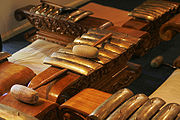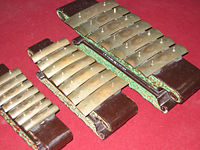
Saron (instrument)
Encyclopedia

Indonesia
Indonesia , officially the Republic of Indonesia , is a country in Southeast Asia and Oceania. Indonesia is an archipelago comprising approximately 13,000 islands. It has 33 provinces with over 238 million people, and is the world's fourth most populous country. Indonesia is a republic, with an...
, which is used in the gamelan
Gamelan
A gamelan is a musical ensemble from Indonesia, typically from the islands of Bali or Java, featuring a variety of instruments such as metallophones, xylophones, drums and gongs; bamboo flutes, bowed and plucked strings. Vocalists may also be included....
. It typically consists of seven bronze
Bronze
Bronze is a metal alloy consisting primarily of copper, usually with tin as the main additive. It is hard and brittle, and it was particularly significant in antiquity, so much so that the Bronze Age was named after the metal...
bars placed on top of a resonating frame (rancak). It is usually about 20 cm (8 in) high, and is played on the floor by a seated performer. In a pelog
Pelog
Pelog is one of the two essential scales of gamelan music native to Bali and Java, in Indonesia. The other scale commonly used is called slendro. Pelog has seven notes, but many gamelan ensembles only have keys for five of the pitches...
scale, the bars often read 1-2-3-5-6-7 across (the number four is not used because of its relation to death) (in kepatihan numbering); for slendro
Slendro
Slendro is a pentatonic scale, one of the two most common scales used in Indonesian gamelan music, the other being pélog.-Tuning:...
, the bars are 6-1-2-3-5-6-1; this can vary from gamelan to gamelan, or even among instruments in the same gamelan. Slendro instruments commonly have only six keys. It provides the core melody (balungan
Balungan
The balungan is sometimes called the "core melody" of a Javanese gamelan composition. This corresponds to the view that gamelan music is heterophonic: the balungan is then the melody which is being elaborated....
) in the gamelan orchestra.
Varieties

- Saron panerus (also: peking)
- Saron barung (sometimes just saron)
- Saron demung (often just called demung)
Each one of those is pitched an octave
Octave
In music, an octave is the interval between one musical pitch and another with half or double its frequency. The octave relationship is a natural phenomenon that has been referred to as the "basic miracle of music", the use of which is "common in most musical systems"...
below the previous. The slenthem
Slenthem
The slenthem is a Javanese metallophone which makes up part of a gamelan orchestra.The slenthem is part of the gendér family. It consists of a set of bronze keys comprising a single octave: there are six keys when playing the slendro scale and seven when playing the pelog...
or slentho
Slentho
The slentho is a musical instrument of the gamelan. It is similar to the saron family of instruments, and would be its lowest member . Like those instruments, it has seven keys in the same arrangement, over a resonator box, and is hit with a wooden mallet...
performs a similar function to the sarons one octave below the demung.
Playing techniques
The sarons are struck with a mallet (tabuh). Typically the striking mallet is angled to the right to produce a fuller sound. Demung and saron barung generally use a wooden mallet, while the peking mallet is made of a water buffalo horn, which gives it a shriller sound. The other hand,is used to dampen the previous note by grasping the key, in order to prevent a muddy sound. On repeated notes, the note is usually dampened half a beat before it is struck again.The saron barung and demung usually play less often and more simple parts. These are the usual techniques for playing them:
- Mbalung: playing the balunganBalunganThe balungan is sometimes called the "core melody" of a Javanese gamelan composition. This corresponds to the view that gamelan music is heterophonic: the balungan is then the melody which is being elaborated....
melody as notated, without elaboration - Tabuhan pinjalan: playing an interlocking pinjalan pattern between the saron barung, demung, and slenthemSlenthemThe slenthem is a Javanese metallophone which makes up part of a gamelan orchestra.The slenthem is part of the gendér family. It consists of a set of bronze keys comprising a single octave: there are six keys when playing the slendro scale and seven when playing the pelog...
, which fills in the offbeats of the balungan - Tabuhan imbal: playing an interlocking imbalImbalImbal or imbalan is a technique used in Javanese gamelan. It refers to a rapid alternation of a melodic line between instruments, in a way similar to hocket in medieval music or kotekan in Balinese gamelan....
pattern between two of the same instruments, usually either saron barung or demung. Note that the dampening must happen as soon as the other performer plays a note; this is usually twice as soon as when playing by oneself. - Pancer: sometimes a note is added between balunganBalunganThe balungan is sometimes called the "core melody" of a Javanese gamelan composition. This corresponds to the view that gamelan music is heterophonic: the balungan is then the melody which is being elaborated....
notes if there is a great deal of space between them (i.e., it is in a slow iramaIramaIrama is a concept used in Javanese gamelan music, describing melodic tempo and relationships in density between the balungan, elaborating instruments, and gong structure. It is distinct from tempo , as each irama can be played in different tempi.One way to think of irama is to use the most...
). This is called a pancer.
Saron panerus has distinctive patterns which make it different from the other sarons. It usually plays more often, and keeps a constant beat going throughout a piece. Its playing techniques include:
- Nacah lamba: playing the balungan (with repeated notes if necessary, depending on the iramaIramaIrama is a concept used in Javanese gamelan music, describing melodic tempo and relationships in density between the balungan, elaborating instruments, and gong structure. It is distinct from tempo , as each irama can be played in different tempi.One way to think of irama is to use the most...
) - Nacah selang-seling: playing the balungan in pairs of notes (which may be repeated), making a more elaborate variation on the phrase
- Imbal-imbalan: similar to tabuhan imbal for the other sarons
History
The earliest known appearance of a single-octave saron is in a relief at BorobudurBorobudur
Borobudur, or Barabudur, is a 9th-century Mahayana Buddhist monument near Magelang, Central Java, Indonesia. The monument comprises six square platforms topped by three circular platforms, and is decorated with 2,672 relief panels and 504 Buddha statues...
, from the 9th century. It was formerly supposed that the saron derived from the decomposition of the gambang gangsa, after it fell out of use. Mantle Hood
Mantle Hood
Mantle Hood was an American ethnomusicologist. Among other areas, he specialized in studying gamelan music from Indonesia. Hood pioneered, in the 1950s and 1960s, a new approach to the study of music, and the creation at UCLA of the first American university program devoted to ethnomusicology...
rejected this hypothesis, and associates the preference for a single octave with the characteristic shape of the cadence
Cadence (music)
In Western musical theory, a cadence is, "a melodic or harmonic configuration that creates a sense of repose or resolution [finality or pause]." A harmonic cadence is a progression of two chords that concludes a phrase, section, or piece of music...
in the pathet
Pathet
The pathet is an organizing concept in gamelan music. It is difficult to explain, but is similar to the melody types, that is, for example, modes, ragas, or maqamat, of other musics....
. There is no evidence that the gambang gangsa is older than the saron; indeed, it may be younger.

